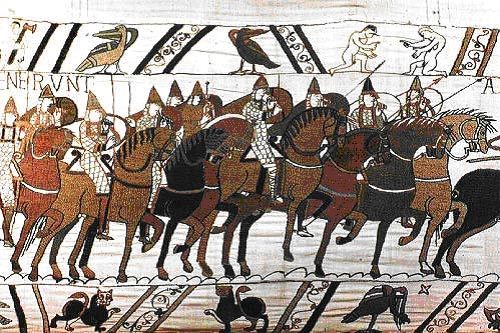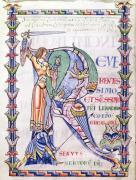Cards In This Set
| Front | Back |
 What is this? |
Bronze doors at St. Michael’s, Hildesheim Germany
commissioned by Bishop BernwardOttonian
Made in one cast—which was pretty revolutionary. Usually you had wood door and then bronze panels attached, this was done all at once. Bernward went to Rome and seen bronze doors there. He figured out how to do casting for these doors. He didn’t do the design, but figured out how to do it. Start with Old Testament goes down then over then up. Corresponds OT scene with NT scene. Starts with creation of Eve, intro of Adam to Eve, temptation of Eve, fall, confrontation about fall, expulsion from Garden, bottom scene Jacob wrestling with angel, annunciation on bottom right, nativity, third to top is crucifixion Theological pairing. Crucifixion across from Adam’s fall. Resurrection versus creation. Doors are 16’6 feet tall. Each panel is 2 feet tall each. You can see detail, figures are fairly simplistic, sausage arms and legs—not correct proportions. 1015- haven’t been trained in this classical type of art, idea is still is more important than message This is still scriptures for the illiterate. |
 What is this? |
Cruficix of Gero commissioned by Archbisohp Gero for Cologne Cathedral,
Germany 970 painted woodOttonian
Why now? We’re seeing revival of sculpture in the round. One of first sculptures we see in round. The figure of Christ is lifesize. 6.’2” Reliquary- oject that holds relics. This one holds some thorns from the crown of thorns. In back holds the relic, they use this as part of mass Would be behind altar, puts together doctrine of the idea that drinking wine and wafer is literally taking of Christ’s blood and body. One of the first examples where we see a dead Christ.Body sagging, hands are bearing weight Interesting mix between naturalism and abstraction Body is elongated, especially in toes, but you can see tendons in arms, and fairly naturalistic drapery Simplified, but naturalistic. |
 What is this? |
Otto 3 enthroned, from gospel book of Otto IIIOttonian
Dedicatory page—first page in manuscript Otto I enthroned, scepter and orb equal power. Hierarchy of scale. Otto is clearly larger seated than everybody standing. bald men on his right are clergyman Men on left indicative of city Combo of church and state Architecture simply to signify that it’s taking in place inside. Pink upper colors trying to show sunset, but doesn’t accomplish that. Trying to show atmosphere, don’t succeed. Drapery/figures See a little bit of the body underneath the drapery, not very naturalistic Figures seems to be floating, slightly cartoonish, attempt at naturalism but don’t succeed. |
 What is this? |
St. Sernin at Toulouse France Romanesque
Small chapels off ambulatory Pilgrims look at relic, pray, and not disrupt things going on in other portion of church. The epitome of pilgrimage Romaneque church, basilica latin cross plan Huge cross and tower over center Apse, ambulatory with radiating chapels. Two part elevation The nave arcade, and above there’s the clerestory. Not a lot of interior delineation Two doors, two side aisles on either side, go out without disturbing church. Relatively good sixed piers and then piers at crossing to support tower that goes above it. Built up of form. Nave and side aisles that are lower in height than nave itself, everything built up to tower in center. Tower acts a beacon. Took from 1070-1120 to build.( Often took 100 years to build a cathedral) First use of interior vaulting—round-barrel vaulting bands Is band vaulting, bands start at floor and then go to ceiling. Did this because stone roof is more fire resistant and helps with acoustics. Use complete row of piers because vaulting is so heavy. |
|
What is Pilgrim's Guide to Santiago
|
· Pilgrim’s guide to Santiago
Medieval travel guide Tells about towns, people/towns to avoid, where to stop, describes mannerisms of people. Travel guide from 1000 years ago. |
 What is this? |
·
Façade
sculpture, Cathedral Modena, Italy Artist: Wiligelmus Romanesque
o
Creation and fall of Adam and Eve.
§
Reminiscent of sarcophagus of Junius Bassus
·
There’s columns that separate scenes not
exactly, but pretty much.
o
Classical motif that we haven’t seen in 700
years or so (since fall of Rome)
o
On left Christ in majesty in mandorla reading
scripture
o
Creation of Adam, creation of Eve. And then
temptation scene,
o
Long arms, big bellies, elongated fingers,
proportions are off.
·
No contrapposto not really individualized.
·
Taking story from old sarcophagus but not style.
o
Not necessarily consistent in depictions scene
to scene.
|
 What is this? |
·
Tympanum
of St. Lazare, Autun, France Artist: Gislebertus Romanesque
o
Identity him by inscription.
o
Last Judgement theme.
o
Very simplified, Christ in judgement in mandorla
in center.
o
He’s not very realistically seated. Don’t know
how to do foreshortening to make him look like he’s sitting. No naturalism in
drapery.
o
Not common, but not unusual to see this.
o
Save are on right hand of Christ,
judgment/damned on left.
§
Don’t see nudity unless it’s Adam or Eve or the
damned in hell.
§
Demons are trying to rig souls, if damned, hands
grab them and push them down below.
o
Trying to scare you into obedience.
|
 What is this? |
·
Baptismal
Font, Artist: Rainer of Huy Romanesque
o
2”1” tall
o
Resting on back of twelve oxens
o
From Notre-dame-des-Fonts in Liege, Belgium
o
Made of bronze
§
Looking at early Christian ivory
o
John the Baptist and Christ, Christ is beardless
(looks to be in dress, but he’s in river) central figure
o
Drapery is pretty naturalistic
o
Above Christ see God’s head and dove. Shows all
three members of godhead.
|
 What is this? |
·
Bayeux
Tapestry Romanesque
o
One of the few examples of non-Christian,
secular art.
§
This is because church had money, most rulers
are Christian.
o
This is thought to be commissioned by William
the Conqueror
§
Depicts the battle of Hastings.
o
It’s 300 feet long,
o
First scene Edward’s death
§
Hand of God reaching from sky
o
Second scene
§
Mythical birds, shows naturalism in colors as
well as more stylized.
§
Dead are laying on ground
o
Description of events, on a whole not very
naturalistic, exp in terms of ppl, and depth
o
How they see secular life
o
Depicts the war from the Norman’s view. Most
likely done by woman artists.
o
Not much background, shows how they see
surroundings.
|
 What is this? |
·
St.
George and the dragon Romanesque
o
Initial R with knight fighting dragons
o
Historiated initial- large letter that’s highly
decorated that starts word.
o
This one is 13’ tall, takes up most of the paper
o
More elaborate than most of these.
o
Knights is dressed in contemporary clothing
(cont=12th century)
o
His knave is helping him who is actually doing
killing and supporting knight
o
This is kind of a jab at the nobility saying
that servants do everything
o
Decorative, but very abstract, not good sense of
drapery
o
No background or depth
|
 What is this? |
Mo Moses expounding the law Artist Master Hugo from the Bury Bible Romanesque
o
The images are done in dual frame/dual image
format. Two scenes that are set in single frame, with partial dividing frame
o
The frame itself is decorative, but doesn’t act
as window more like border
o
Moses and Joshua on left.
o
Dressed in cont. 12th century Jewish
clothing, and Moses and Joshua dressed in robes of OT times.
o
Moses as horns, comes from mistranslation—he
comes down from Mt. Sinai, verse says he shone with light, but they said he
came down with horns of light even still.
o
He’s telling them law at top, in bottom pointing
out clean/unclean animals
o
Very stylistic and abstract. Bodies are more of
an s curve, drapery is abstract. Drapery is more swirly than anything else.
o
It doesn’t give you a good sense of depth
o
Figures are elongated, especially hands.
o
Brightly colored and abstract.
|
 What is this? |
·
Abbey
church of St. Denis, France 1140-44. Near Paris, France Early Gothic
o
First truly gothic church
o
Site of martyrdom of St. Denis (guy who brought
Christianity to French)
o
It had been a sacred site from 5th
century on.
o
He’s the Abbot in the church
§
Has a lot of royal connections, lot of kings
buried there.
|
 What is this? |
·
Suger on
the Abbey Church of St. Denis Early Gothic
o
Abbot Suger- has relevation, realizes it is too
small. Decides to expand it. Writes
about inspiration, exactly what he did, and it’s art treasures. Many colored gems carries him away from
worldly cares. For him it’s a spiritual
experience.
§
This style spreads rapidly
o
Went to school with King Louis 7th,
they remained close.
o
Writes about revelation to expand church and
tells about original feast/festival where he decides to change it.
o
Decides to expand original church not destroy.
o
Started with eas end. Used cross-vaulting more
than they had been using. Wanted to get rid of masonry between windows.
o
West façade isn’t really fabulous (looks
Romanesque)
o
East side is spectacular
§
Dionyusus patron of France
§
Pseudo Dionysus- mystic in Iraq
§
Dionysus- christ’s time
·
From these Dionysus wants church infused with
heavenly light
o
Pointed arch, knocks out wall, and uses stained
glass
§
beginning of Gothic era.
·
Vary heights,
pointed arch doesn’t result in dipping down that we saw earlier.
o
Lessens amount of support you need, creating
possibility for stained glass.
·
Combo of 4 and 5 point vaulting.
|
 What is this? |
 · Royal Portals, Cathedral, Chartres, France o Low gothic § very elongated, stylized drapery, § columnar feel · feel like they are still part of the architecture § faces aren’t individualized · slightly distinguished, but pretty basic and stylized o High Gothic § Less elongated, § Are individualized, look more like a statue than a column |
 What is this? |
· Annunciation and Visitation, portal sculpture, Cathedral, Reims High Gothico First set§ First set is very plain, not realistic, slight s curve, no body, no emotion. Bodies aren’t proportional, elongated,o Second set (jamb statues)§ More realistic§ Looking at classical sculpture§ Drapery is very naturalistic, pulled against body to accentuate bodies , much more proportion· Not architectural, clearly sculptural, designed to be works of art
|



